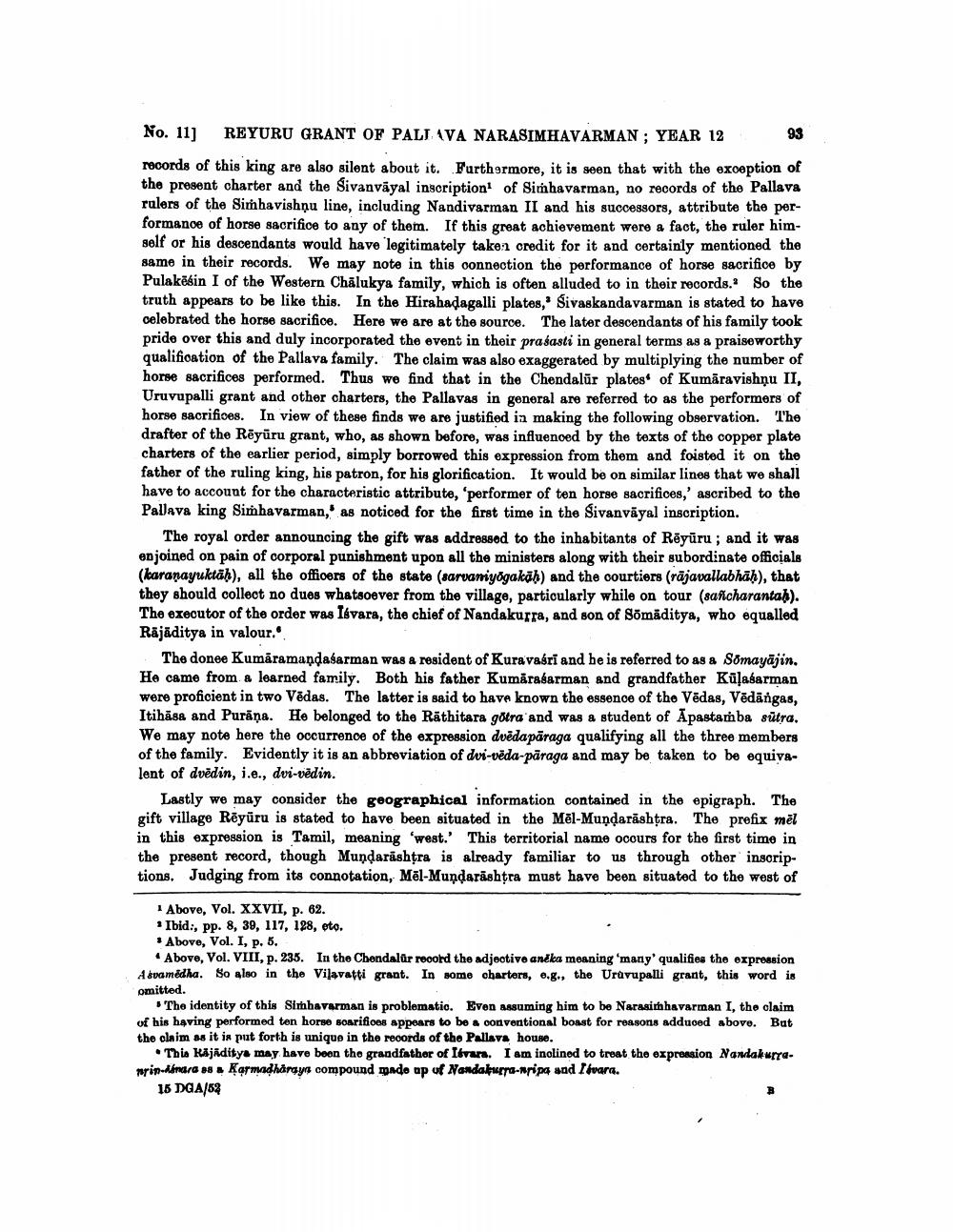________________
No. 11] REYURU GRANT OF PALTAVA NARASIMHAVARMAN ; YEAR 12
9
3
records of this king are also silent about it. Furthermore, it is seen that with the exoeption of the present charter and the Sivanvāyal inscription of Sinhavarman, no records of the Pallava rulers of the Simhavishņu line, including Nandivarman II and his successors, attribute the performance of horse sacrifice to any of them. If this great achievement were a fact, the ruler himself or his descendants would have legitimately take a credit for it and certainly mentioned the same in their records. We may note in this connection the performance of horse sacrifice by Pulakësin I of the Western Chalukya family, which is often alluded to in their records. So the truth appears to be like this. In the Hirahadagalli plates, Sivaskandavarman is stated to have celebrated the horse sacrifice. Here we are at the source. The later descendants of his family took pride over this and duly incorporated the event in their prasasti in general terms as a praiseworthy qualification of the Pallava family. The claim was also exaggerated by multiplying the number of horse sacrifices performed. Thus we find that in the Chendalur plates of Kumāravishņu II, Uruvupalli grant and other charters, the Pallavas in general are referred to as the performers of horse sacrifices. In view of these finds we are justified in making the following observation. The drafter of the Rēyuru grant, who, as shown before, was influenced by the texts of the copper plate charters of the earlier period, simply borrowed this expression from them and foisted it on the father of the ruling king, his patron, for his glorification. It would be on similar lines that we shall have to account for the characteristic attribute, 'performer of ten horse sacrifices,' ascribed to the Pallava king Simhavarman,' as noticed for the first time in the Sivanvāyal inscription.
The royal order announcing the gift was addressed to the inhabitants of Röyüru; and it was enjoined on pain of corporal punishment upon all the ministers along with their subordinate officials (karanayuktāb), all the officers of the state (sarvamiyðgakāb) and the courtiers (rājavallabhāh), that they should collect no dues whatsoever from the village, particularly while on tour (sancharantah). The executor of the order was Isvara, the chief of Nandakurra, and son of Somaditya, who equalled Rājāditya in valour.
The donee Kumāramandasarman was a resident of Kuravasri and he is referred to as a Somayājin. He came from a learned family. Both his father Kumārabarman and grandfather Kūļašarman were proficient in two Vēdas. The latter is said to have known the essence of the Vēdas, Vēdāngas, Itihase and Purāņa. He belonged to the Räthitara gotra and was a student of Apastamba sutra. We may note here the occurrence of the expression dvēda pāraga qualifying all the three members of the family. Evidently it is an abbreviation of dvi-vēda-paraga and may be taken to be equivalent of dvēdin, i.e., dvi-vēdin.
Lastly we may consider the geographical information contained in the epigraph. The gift village Rēyuru is stated to have been situated in the Mêl-Mundarăshtra. The prefix mēl in this expression is Tamil, meaning 'west.' This territorial name ocours for the first time in the present record, though Mundarashtra is already familiar to us through other inscriptions. Judging from its connotation, Mēl-Mundarashtra must have been situated to the west of
1 Above, Vol. XXVII, p. 62. 1 Ibid., pp. 8, 39, 117, 128, eto. * Above, Vol. I, p. 5.
* Above, Vol. VIII, p. 235. In the Chendalar record the adjective andka meaning 'many' qualifies the expression A swamedha. So also in the Vilavatti grant. In some charters, 6.g., the Uravupalli grant, this word is omitted.
The identity of this Simhavarman is problematic. Even assuming him to be Narasimhavarman I, the claim of his having performed ten horse soarifices appears to be a conventional boast for reasons adduced abovo. Bat the claim as it is put forth is unique in the records of the Pallava house.
This Kajāditya may have been the grandfather of Isrars. I am inclined to treat the expression Nawakuramorin-denda as a Kormadhara yn compound made up of Nandakupa-aripa sad Ilvara.
15 DGA/52




